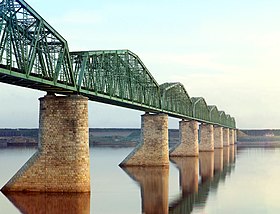Eurasian Land Bridge
The Eurasian Land Bridge (Russian: Евразийский сухопутный мост, romanized: Yevraziyskiy sukhoputniy most), sometimes called the New Silk Road (Новый шёлковый путь, Noviy shyolkoviy put'), is the rail transport route for moving freight and passengers overland between Pacific seaports in the Russian Far East and China and seaports in Europe.
With the October 2013 completion of the rail link across the Bosphorus under the Marmaray project, the New Eurasian Land Bridge now theoretically connects to Europe via Central and South Asia.
The Silk Road was not a specific thoroughfare, but a general route used by traders to travel, much of it by land, between the two continents along the Eurasian Steppes through Central Asia.
The 8,000-kilometre-long (5,000 mi) route was used to exchange goods, ideas and people primarily between China and India and the Mediterranean and helped create a single-world system of trade between the civilisations of Europe and Asia.
[2] Exports from Asia transported along the Silk Road included fabrics, carpets, furs, weapons, utensils, metals, farm produce, livestock and slaves.
Civilisations active in trading during the road's history included Scythia, Ancient and Byzantine Greece, the Han and Tang dynasties, Parthia, Rouran, Sogdiana, Göktürks, Xiongnu, Yuezhi and the Mongol Empire.
[9] While the Trans-Siberian has always been used by the Tsarist, Soviet and modern Russian government to project political power into their territories in Asia, in the 1960s it was opened by the USSR as an international trade route connecting the Western Pacific with Europe.
Also, the Trans-Siberian links directly to railways which ultimately connect, via Finland and Sweden, to the year-round ice-free port of Narvik in Norway.
[11] In an effort to attract use of the Trans-Siberian to transport goods from Japan, China, and Korea to Europe, in the mid-1990s Russia lowered tariffs on freight using the railway.
[12] In February and March 2011, Japan's Ministry of Land, Infrastructure, Transport and Tourism sponsored a test of the route by shipping roof tiles to Europe via the Trans-Siberian.
It will involve a railway bridge between across the Amur (Heilong) River, connecting Tongjiang in China's Heilongjiang province with Nizhneleninskoye in Russia's Jewish Autonomous Oblast.
[26][27] On 4 November 2010, the project director, Wang Jin, told Xinhua News Agency that construction on the bridge would begin in January 2011.
The first train of 50 containers, carrying a mixed load of clothes, ceramics and electronics (for the Fujitsu company), travelled on tracks operated by six different railways.
[39][40] Hartmut Mehdorn, chairman of Deutsche Bahn (DB), stated in March 2008 that regularly scheduled, weekly China-Germany freight services should be in operation by 2010.
[42] Another test run, from Chongqing to Duisburg via Alashankou crossing, Kazakhstan, Russia, Belarus, and Poland took place in March–April 2011, covering 10,300 km (6,400 mi) in 16 days.
[47] The service is typically used for valuable and somewhat time-sensitive cargo where the time advantage of rail over ship is essential, which, however, is heavy enough to make the cost saving vs. air transport noticeable.
Typical cargoes include complex machinery and spare parts (in both directions), as well as high-end groceries and consumer goods (primarily toward China).
[47] While major customers ship their products by full container load, freight forwarders also make it possible to send less-than-container shipments.
Due to longer distance, insufficient service, and border crossings, this route has not regularly been used for direct transport from China to Europe.
Large facilities to carry out this procedure exist at most border crossing between the "Russian" and "standard" gauge territories (e.g., at Zabaykalsk[20] or Erenhot)[63] Changing the bogies on a rail car takes hours and special, heavy equipment.
According to Choi Yeon-Hye, a professor of marketing and management at the Korea National Railway College, a rail connection from Busan to Rotterdam would cut shipping time from 26 to 16 days and save $800 per container of freight.
[69][70] The South Korean government announced on 2 December 2009 that it would conduct an economic and technical study on the feasibility of constructing undersea tunnels for transporting goods and people to and from the country directly to Kyushu, Japan and Shandong, China.
[72] Chinese leaders have called for the establishment of free trade zones at both ends of the Eurasian Land Bridge to facilitate development.
[73] Said Khalid Malik, United Nations Resident Coordinator in China, "If this comes true, it will enable the continental bridge to play its due role in enhancing co-operation between Asia and Europe, and promoting world peace and development.
The plans include construction of a high-speed rail line from Kunming to Vientiane, beginning in April 2011, with a possible future extension to Bangkok.
[75] On 15 December 2011, Russian Prime Minister Vladimir Putin announced that a rail link was being considered between Sakhalin Island and Japan.
[76] In April 2007 the Russian government announced that it was considering building a double track broad gauge rail tunnel under the Bering Strait between Chukotka and Alaska.
The tunnel, as projected, would be 100 km (60 mi) long and would include oil and gas pipelines, fiber optic cables and power lines.
[78] The project, as envisioned, would connect the Trans-Siberian via Komsomolsk-on-Amur/Yakutsk in Siberian Russia with the North American rail network (gauge to be widened) at Fort Nelson, British Columbia, Canada, a distance of 6,000 km (3,700 mi).
[79] Other leaders, including Wally Hickel, Lyndon LaRouche, Sun Myung Moon, and the 14th Dalai Lama have also advocated the construction of a tunnel or bridge across the strait.









